Managing the Historical Agricultural Landscape in the Sicilian Anthropocene Context. The Landscape of the Valley of the Temples as a Time Capsule
Abstract
1. Introduction
2. Levels of Awareness of the Ecological Footprint of Humankind in the Anthropocene
3. Managing Anthropocene Landscapes
4. Materials and Methods
4.1. The Valley of the Temples of Agrigento as a Case Study
“with the arrival of the Arabs on the island, an authentic agrarian revolution began: introduction of new crops, innovative soil improvement techniques and hydraulic systems which contributed to a better use of water resources, a temporal and spatial differentiation of production and a more integrated view of the agricultural system in all its components (irrigation, energy, micro-climate and aesthetic functions): a completely different approach to agriculture which, for its holistic nature, could be indeed defined as agroecology. Such structural revolution marked deeply the Sicilian agrarian landscape; it was the beginning of the coltura promiscua system, based on an authentic intercropping of the fruit trees”[35], p. 140.
“has taken on the forms of parasitic speculation which have reached an aberrant extent in this city; the rights of nature and history have been trampled on, the physical and historical characteristics of our country have been ignored (…). The work was done in such a monstrous way that the landslide that engulfed a third of the City of Temples appeared as an inevitable, indeed coherent, reaction of nature (…) to the way in which its laws have been ignored or trampled on”[41], p. 58; author’s translation.
4.2. Change in Landscape Ecomosaics
5. Results
5.1. Different Degree of Transformation in Landscape Ecomosaics
5.2. Historical Iconography of the Agricultural Landscape of the Valley of the Temples
6. Discussion
6.1. Main Issues of Agricultural–Forest Management in the Valley of the Temples
6.2. The Living Museum of the Almond Tree for Safeguarding Intraspecific Biodiversity
6.3. The Mediterranean Garden
6.4. The Productive Dimensions of the Historical Landscape. The Landscape Regeneration Project
6.4.1. Appreciating the Environmental Heritage
6.4.2. Agricultural Production
6.4.3. Environmental Education
6.4.4. Restoration and Requalification of the Landscape
7. Conclusions
“without major catastrophes like an enormous volcanic eruption, an unexpected epidemic, a large-scale nuclear war, an asteroid impact, a new ice age, or continued plundering of Earth’s resources by partially still primitive technology (…) mankind will remain a major geological force for many millennia, maybe millions of years, to come. To develop a world-wide accepted strategy leading to sustainability of ecosystems against human induced stresses will be one of the great future tasks of mankind, requiring intensive research efforts and wise application of the knowledge (…). An exciting, but also difficult and daunting task lies ahead of the global research and engineering community to guide mankind towards global, sustainable, environmental management”[1], p. 18.
Funding
Institutional Review Board Statement
Informed Consent Statement
Data Availability Statement
Acknowledgments
Conflicts of Interest
References
- Crutzen, P.J.; Stoermer, E.F. The ‘Anthropocene’. Int. Geosph. Biosph. Programme (IGBP) Glob. Chang. Newsl. 2000, 41, 17–18. [Google Scholar]
- Crutzen, P.J. Benvenuti nell’Antropocene. L’uomo ha cambiato il clima, la Terra entra in una nuova era; Mondadori: Milano, Italy, 2005. [Google Scholar]
- Steffen, W.; Crutzen, P.J.; McNeill, J.R. The Anthropocene: Are Humans Now Overwhelming the Great Forces of Nature? Ambio 2007, 36, 614–621. [Google Scholar] [CrossRef]
- Rockström, J.; Steffen, W.; Noone, K.; Persson, Å.; Chapin, F.S., III; Lambin, E. Planetary Boundaries: Exploring the safe operating space for humanity. Ecol. Soc. 2009, 14, 2. [Google Scholar] [CrossRef]
- Barbera, G. Antropocene, Agricoltura e Paesaggio; Aboca: Sansepolcro, Italy, 2019. [Google Scholar]
- Campbell, B.M.; Beare, D.J.; Bennett, E.M.; Hall-Spencer, J.M.; Ingram, J.S.; Jaramillo, F. Agriculture Production as a Major Driver of the Earth System Exceeding Planetary Boundaries. Ecol. Soc. 2017, 22, 4. [Google Scholar] [CrossRef]
- Lennon, M. Nature conservation in the Anthropocene: Preservation, restoration and the challenge of novel ecosystems. Plan. Theory Pract. 2015, 16, 285–290. [Google Scholar] [CrossRef]
- Barbera, G.; Biasi, R.; Marino, D. I paesaggi Agrari Tradizionali. Un Percorso per la Conoscenza; FrancoAngeli: Milano, Italy, 2014. [Google Scholar]
- Bazan, G.; Speciale, C.; Castrorao Barba, A.; Cambria, S.; Miccichè, R.; Marino, P. Historical Suitability and Sustainability of Sicani Mountains Landscape (Western Sicily): An Integrated Approach of Phytosociology and Archaeobotany. Sustainability 2020, 12, 3201. [Google Scholar] [CrossRef]
- Bazan, G.; Castrorao Barba, A.; Rotolo, A.; Marino, P. Vegetation series as a marker of interactions between rural settlements and landscape: New insights from the archaeological record in Western Sicily. Landsc. Res. 2020, 45, 484–502. [Google Scholar] [CrossRef]
- Agnoletti, M. Italian Historical Rural Landscapes: Dynamics, Data Analysis and Research Findings; Springer: Dordrecht, The Netherlands, 2013. [Google Scholar]
- Barbera, G.; Cullotta, S. The Traditional Mediterranean Polycoltural Landscape as Cultural Heritage: Its Origin and Historical Importance, Its Agro-Silvo-Pastoral Complexity and the Necessity of Its Identification and Inventory. In Biocultural Diversity in Europe; Agnoletti, M., Emanueli, F., Eds.; Springer: Dordrecht, The Netherlands, 2016. [Google Scholar]
- Cevasco, R.; Moreno, D.; Hearn, R. Biodiversification as an historical process: An appeal for the application of historical ecology to bio-cultural diversity research. Biodivers. Conserv. 2015, 24, 3167–3183. [Google Scholar] [CrossRef]
- Lewis, S.L.; Maslin, M.A. Il Pianeta Umano; Einaudi: Torino, Italy, 2019. [Google Scholar]
- Crutzen, P.J. Geology of mankind. Nature 2002, 415, 3. [Google Scholar] [CrossRef]
- McNeill, J.R.; Engelke, P. La Grande Accelerazione. Una Storia Ambientale dell’Antropocene Dopo il 1945; Einaudi: Torino, Italy, 2018. [Google Scholar]
- Foster, J.B.; Holleman, H.; Clark, B. Imperialism in the Anthropocene. Mon. Rev. 2019, 71, 70–88. [Google Scholar] [CrossRef]
- Meadows, D.H.; Meadows, D.L.; Randers, J.; Behrens, W.W. I limiti dello sviluppo. Rapporto del System Dynamics Group Massachusetts Institute of Technology (MIT) per il Progetto del Club di Roma sui Dilemmi Dell’umanità; Mondadori: Milano, Italy, 1972. [Google Scholar]
- Diffenbaugh, N.S.; Burke, M. Global Warming Has Increased Global Economic Inequality. Proc. Natl. Acad. Sci. USA 2019, 116, 9808–9810. [Google Scholar] [CrossRef]
- Pellegrino, G.; Di Paola, M. Nell’Antropocene. Etica e politica alla fine di un mondo; DeriveApprodi: Roma, Italy, 2018. [Google Scholar]
- Rockström, J.; Steffen, W.; Noone, K.; Persson, Å.; Chapin, F.S.; Lambin, E.F. A safe operating space for humanity. Nature 2009, 461, 472–475. [Google Scholar] [CrossRef] [PubMed]
- Steffen, W. Global Change and the Earth System. A Planet under Pressure; Springer: Berlin/Heidelberg, Germany; New York, NY, USA, 2004. [Google Scholar]
- Steffen, W.; Richardson, K.; Rockström, J.; Cornell, S.E.; Fetzer, I.; Bennett, E.M. Planetary Boundaries. Guiding human development on a changing planet. Science 2015, 347, 6223. [Google Scholar] [CrossRef] [PubMed]
- Tarolli, P.; Vanacker, V.; Middelkoop, H.; Brown, A.G. Landscapes in the Anthropocene. State of the Art and Future Directions. Anthropocene 2014, 6. Available online: https://www.sciencedirect.com/science/article/pii/S2213305414000654 (accessed on 15 March 2021). [CrossRef]
- Tscharntke, T.; Klein, A.M.; Kruess, A.; Steffan-Dewenter, I.; Thies, C. Landscape Perspectives on Agricultural Intensification and Biodiversity—Ecosystem Service Management. Ecol. Lett. 2005, 8, 857–874. [Google Scholar] [CrossRef]
- Rockström, J.; Klum, M. Grande Mondo, Piccolo Pianeta. La Prosperità entro i Confini Planetari; Edizioni Ambiente: Milano, Italy, 2015. [Google Scholar]
- Carta, M. Città Aumentate; Il Margine: Trento, Italy, 2021. [Google Scholar]
- Miles, M.M. Birds around the Temple: Construction a Sacred Environment. In Valuing Landscape Classical Antiquity; McInerney, J., Sluiter, I., Eds.; Leiden: Boston, MA, USA, 2016. [Google Scholar]
- De Miro, E. La Valle dei Templi; Sellerio: Palermo, Italy, 1994. [Google Scholar]
- Griffo, P. Akragas—Agrigento; Legambiente: Palermo, Italy, 1998. [Google Scholar]
- Badami, A. Il parco e l’ombra. In Riscoprire il Paesaggio della Valle dei Templi; Leone, M., Ed.; Alaimo: Palermo, Italy, 2003; pp. 113–127. [Google Scholar]
- Badami, A. Caractéristiques urbanistiques du site archéologique d’Akragas. Du site archéologique au Parc Archéologique et Paysager de la Vallée des Temples d’Agrigente. In Patrimoine et Créativité. Une Alliance pour le Développement Durable; Carta, M., Ed.; LISt Lab: Trento, Italy, 2016; pp. 62–87. [Google Scholar]
- Leone, M. Riscoprire il Paesaggio della Valle dei Templi; Alaimo: Palermo, Italy, 2003. [Google Scholar]
- Lo Piccolo, F. Progettare le Identità del territorio. Piani e Interventi per uno Sviluppo Locale Autosostenibile nel Paesaggio Agricolo Della Valle dei Templi di Agrigento; Alinea: Firenze, Italy, 2009. [Google Scholar]
- Ferrara, V.; Ekblom, A.; Wästfelt, A. Biocultural Heritage in Sicilian Olive Groves; The Importance of Heterogeneous Landscapes over the Long Term. In Encyclopedia of the World’s Biomes; Goldstein, M.I., Della Sala, D.A., Eds.; Elsevier: Amsterdam, The Netherlands, 2020; Volume 5, pp. 135–145. [Google Scholar]
- Stagno, A.M. Investigating the effect of changes, Legal access rights and changing lifestyles of rural mountain communities (Ligurian Apennines, Italy, 16th–21st centuries AD). World Archaeol. 2019, 51, 311–327. [Google Scholar] [CrossRef]
- Fiorentini, G.; Trizzino, L. Agrigento, i Templi, il Territorio. Analisi Geometrica dei Rapporti Visuali tra Emergenze Architettoniche e Territorio. Determinazione dei Valori Quantitativi Indisturbati e Della Incidenza del Costruito; Regione Siciliana, Assessorato Beni Culturali e Ambientali: Palermo, Italy, 1989.
- Gucciardo, G. La legge e l’arbitrio. L’abusivismo edilizio in Italia. Il caso della Valle dei Templi di Agrigento; Soveria Mannelli: Rubbettino, Italy, 1999. [Google Scholar]
- Grappelli, G. La frana di Agrigento. Relazione tecnica della Commissione Grappelli. In Città Spazio; Lerici Edizioni: Milan, Italy, 1968; pp. 1–2. [Google Scholar]
- Cannarozzo, T.; Leone, M. Agrigento: Il sistema insediativo, le risorse territoriali e le vicende urbanistiche. In Scuola Internazionale di Studi Avanzati. Viaggio di Architetture ai Margini del Parco Archeologico di Agrigento; Leone, B., Ed.; Flaccovio: Palermo, Italy, 2007. [Google Scholar]
- Alicata, M. La lezione di Agrigento; Editori Riuniti: Roma, Italy, 1966. [Google Scholar]
- Caminneci, V.; Parello, M.C.; Rizzo, M.S. La Persistenza Della Memoria. Vivere il Paesaggio; L’Erma di Bretschneider: Roma, Italy, 2017. [Google Scholar]
- Themuto Barata, F. Les paysages, le patrimoine immatériel et la connectivité du territoire. In Patrimoine et Créativité. Une Alliance pour le Développement Durable; Carta, M., Ed.; LISt Lab: Trento, Italy, 2016; pp. 25–36. [Google Scholar]
- Ferrara, G.; Campioni, G. Paesaggi di idee. Uno sguardo al futuro della Valle dei Templi di Agrigento; Alinea: Firenze, Italy, 2005. [Google Scholar]
- Politecnica. Piano per il Parco archeologico e paesaggistico della Valle dei Templi di Agrigento, Unpublished documentation of the plan. Working group: Ingegneria ed Architettura S.C.a R.L—Ferrara Associati Studio di Progettazione Ambientale—GEO S.p.A.—ECOSFERA S.p.A.—PRAXIS S.r.l.—Studio Associato Silva—Prof. Ing. Vincenzo Cotecchia—Prof. Ernesto De Miro—Prof. Dott. Gualtiero Harrison. 2008.
- Cannarozzo, T. Il piano del Parco Archeologico e Paesaggistico della Valle dei Templi di Agrigento: Risorse, strumenti, attori e nuovi orizzonti di sviluppo locale. In Argomenti di Pianificazione 2009. Contributi per la Riforma Urbanistica in Sicilia; Regione Siciliana Assessorato del Territorio e dell’Ambiente, Dipartimento Regionale Urbanistica, Eds.; Fondazione Federico II: Palermo, Italy, 2009. [Google Scholar]
- Campioni, F.; Ferrara, G. La pianificazione del paesaggio: Principi innovativi ed esperienza applicate. Il caso studio della Valle dei Templi di Agrigento. Ri-Vista Ric. Progettl Paesaggio 2004, 1, 83–97. [Google Scholar]
- Nigrelli, F.C. Il patrimonio territoriale. In Paesaggi di Rovine. Paesaggi Rovinati; Capuano, A., Ed.; Quodlibet Studio: Recanati, Italy, 2014; pp. 158–168. [Google Scholar]
- Lo Pilato, G. Il Paesaggio agrario storico della Valle dei Templi. Ananke 1999, 26, 99–106. [Google Scholar]
- Ingegnoli, V. Fondamenti di Ecologia del Paesaggio; Cittàstudi Edizioni: Milano, Italy, 1993. [Google Scholar]
- Politecnica. Parco Archeologico e Paesaggistico Della Valle dei Templi di Agrigento, Elaborati Analitico-Diagnostici: RA2—Agronomia, Forestazione, Paesaggio Agricolo, Unpublished documentation of the plan. 2003.
- Barbera, G.; Lo Pilato, G. Il Paesaggio della Valle dei Templi, Analisi e Proposte per la sua Salvaguardia e Valorizzazione; Provincia Regionale di Agrigento: Agrigento, Italy, 1995. [Google Scholar]
- Barbera, G.; Di Rosa, M. Il paesaggio agrario della Valle dei Templi. Meridiana 2000, 37, 83–98. [Google Scholar]
- AA.VV. La Valle dei Templi tra Iconografia e Storia; Assessorato Regionale Beni Culturali: Palermo, Italy, 1994. [Google Scholar]
- Bazan, G.; Castrorao Barba, A.; Rotolo, A.; Marino, P. Geobotanical approach to detect land-use change of a Mediterranean landscape: A case study in Central-Western Sicily. Geo J. 2019, 84, 795–811. [Google Scholar] [CrossRef]
- Lo Pilato, G. L’agricoltura della Valle dei Templi: Aspetti economici e paesaggistici. In Il Paesaggio della Valle dei Templi, Analisi e Proposte per la sua Salvaguardia e Valorizzazione; Barbera, G., Lo Pilato, G., Eds.; Provincia Regionale di Agrigento: Agrigento, Italy, 1995; pp. 69–80. [Google Scholar]
- Barbera, G. Il sistema tradizionale del mandorlo nella Valle dei Templi e il Museo Vivente. Italus Hortus 2000, 7, 3–4. [Google Scholar]
- Barbera, G.; Monte, M.; Sottile, F. The almond Museo Vivente F. Monastra: From genetic resources rescue to germplasm collection. Options Méditerranéennes Série A 2005, 63, 79–84. [Google Scholar]
- Barbera, G. L’orto di Pomona. Sistemi Tradizionali Dell’arboricoltura da Frutto in Sicilia; L’Epos: Palermo, Italy, 2000. [Google Scholar]
- Barbera, G. Per un museo vivente della cultura e della biodiversità del mandorlo nella Valle dei Templi. In Il Paesaggio Della Valle dei Templi, Analisi e Proposte per la sua Salvaguardia e Valorizzazione; Barbera, G., Lo Pilato, G., Eds.; Provincia Regionale di Agrigento: Agrigento, Italy, 1995; pp. 81–98. [Google Scholar]
- Light, D.; Creţan, R.; Voiculescu, S.; Jucu, J.S. Introduction: Changing Tourism in the Cities of Post-communist Central and Eastern Europe. J. Balk. Near East. Stud. 2020, 22, 465–477. [Google Scholar] [CrossRef]
- Sereni, E. Storia del Paesaggio Agrario Italiano; Laterza: Roma-Bari, Italy, 1961. [Google Scholar]
- Barbera, G. Il paesaggio agrario della Valle dei Templi. In Riscoprire il Paesaggio della Valle dei Templi; Leone, M., Ed.; Alaimo: Palermo, Italy, 2003; pp. 47–53. [Google Scholar]
- Barbera, G. I sistemi frutticoli tradizionali nella valorizzazione del paesaggio. Italus Hortus 2003, 10, 40–45. [Google Scholar]
- Lo Pilato, G. La riscoperta del paesaggio perduto della Valle dei Templi: L’intervento del FAI nel restauro del Giardino della Kolymbethra. In Riscoprire il Paesaggio della Valle dei Templi; Leone, M., Ed.; Alaimo: Palermo, Italy, 2003; pp. 71–81. [Google Scholar]
- Barbera, G.; La Mantia, T.; Ala, M. Tra utilità e bellezza: Il giardino di agrumi della Kolymbethra nella Valle dei Templi. In I Nostri Giardini. Tutela, Conservazione, Gestione; Cazzato, V., Fresa, M., Eds.; Gangemi: Roma, Italy, 2005; pp. 102–111. [Google Scholar]
- Barbera, G. Giardino della Kolymbethra; FAI (brochure): Milan, Italy, 2018. [Google Scholar]
- Todaro, P.; Barbera, G.; Castrorao Barba, A.; Bazan, G. Qanāts and historical irrigated landscapes in Palermo’s suburban area (Sicily). Eur. J. Post Class. Archaeol. 2020, 10, 335–370. [Google Scholar]
- Baiamonte, G.; Domina, G.; Raimondo, F.M.; Bazan, G. Agricultural landscapes and biodiversity conservation: A case study in Sicily (Italy). Biodiver. Conserv. 2015, 24, 3201–3216. [Google Scholar] [CrossRef]
- Gianguzzi, L.; Bazan, G. The Olea europaea L. var. sylvestris (Mill.) Lehr. forests in the Mediterranean area. Plant Sociol. 2019, 56, 3–34. [Google Scholar]
- Gianguzzi, L.; Bazan, G. A phytosociological analysis of the Olea europaea L. var. sylvestris (Mill.) Lehr. forests in Sicily. Plant Biosyst. Int. J. Deal. Asp. Plant Biol. 2020, 154, 705–725. [Google Scholar] [CrossRef]
- Marino, P.; Castiglia, C.; Bazan, G.; Domina, G.; Guarino, R. Tertiary relict laurophyll vegetation in the Madonie mountains (Sicily). Acta Bot. Gall. 2014, 161, 47–61. [Google Scholar] [CrossRef][Green Version]
- Vesalon, L.; Creţan, R. “Little Vienna” or “European Avant-Garde City”? Branding Narratives in a Romanian City. J. Urban Reg. Anal. 2019, 11, 19–34. [Google Scholar]
- Niles, D. Agricultural Heritage and Conservation Beyond the Anthropocene. In The Oxford Handbook of Public Heritage. Theory and Practice; Labrador, A.M., Silberman, N.A., Eds.; Oxford University Press: Oxford, UK, 2018; pp. 339–354. [Google Scholar]
- Badami, A. The Resilience of the Valley of Temples among natural calamities and social disasters. Dwell. Hearth 2017, 42/43, 66–69. [Google Scholar]
- The Vjosa/Aoos River Ecomuseum: Talking about Our Place; Mediterranean Institute for Nature and Anthropos (Med-INA): Athens, Greece. Available online: https://www.ecomuseum.eu/ (accessed on 15 April 2021).
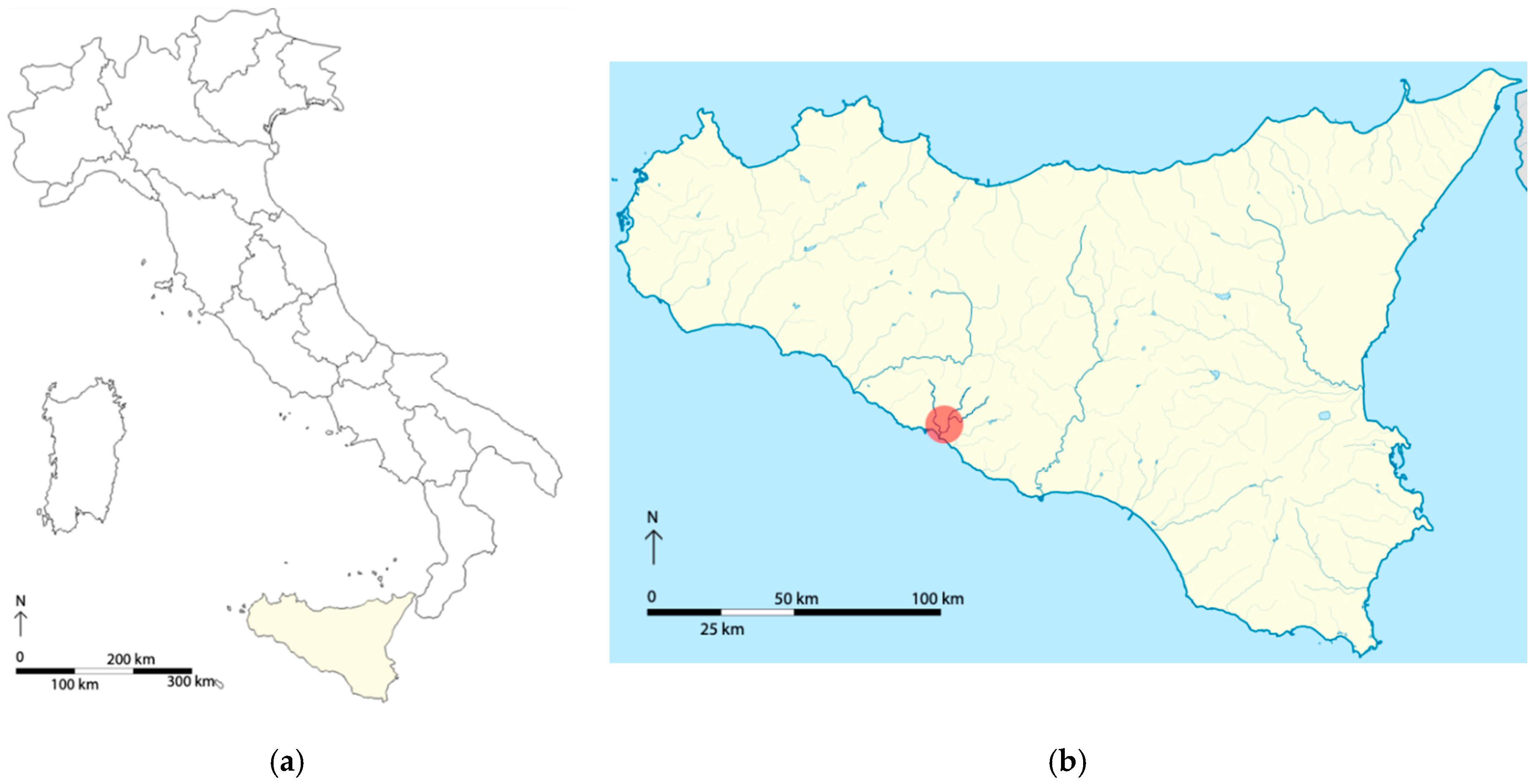


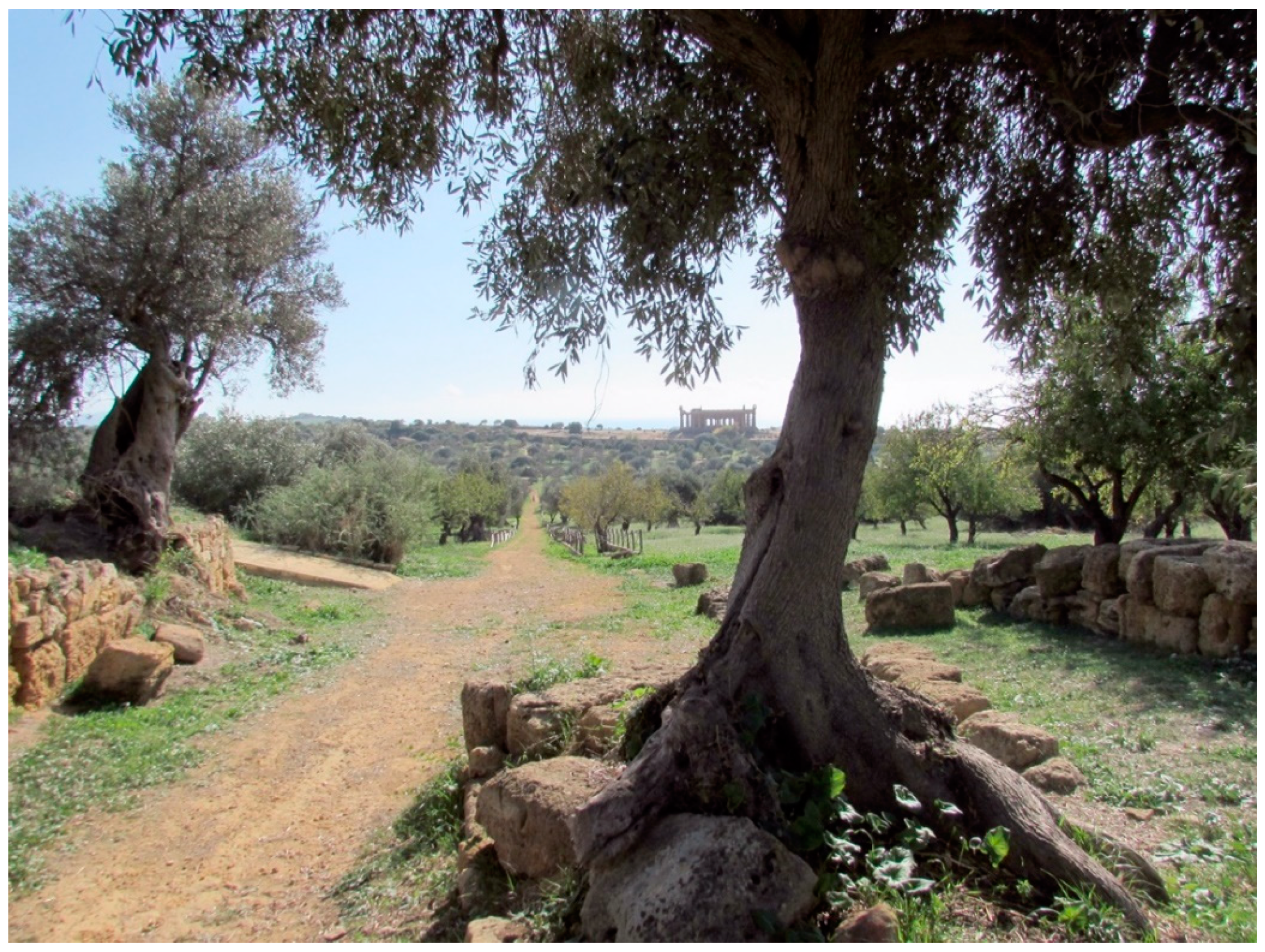
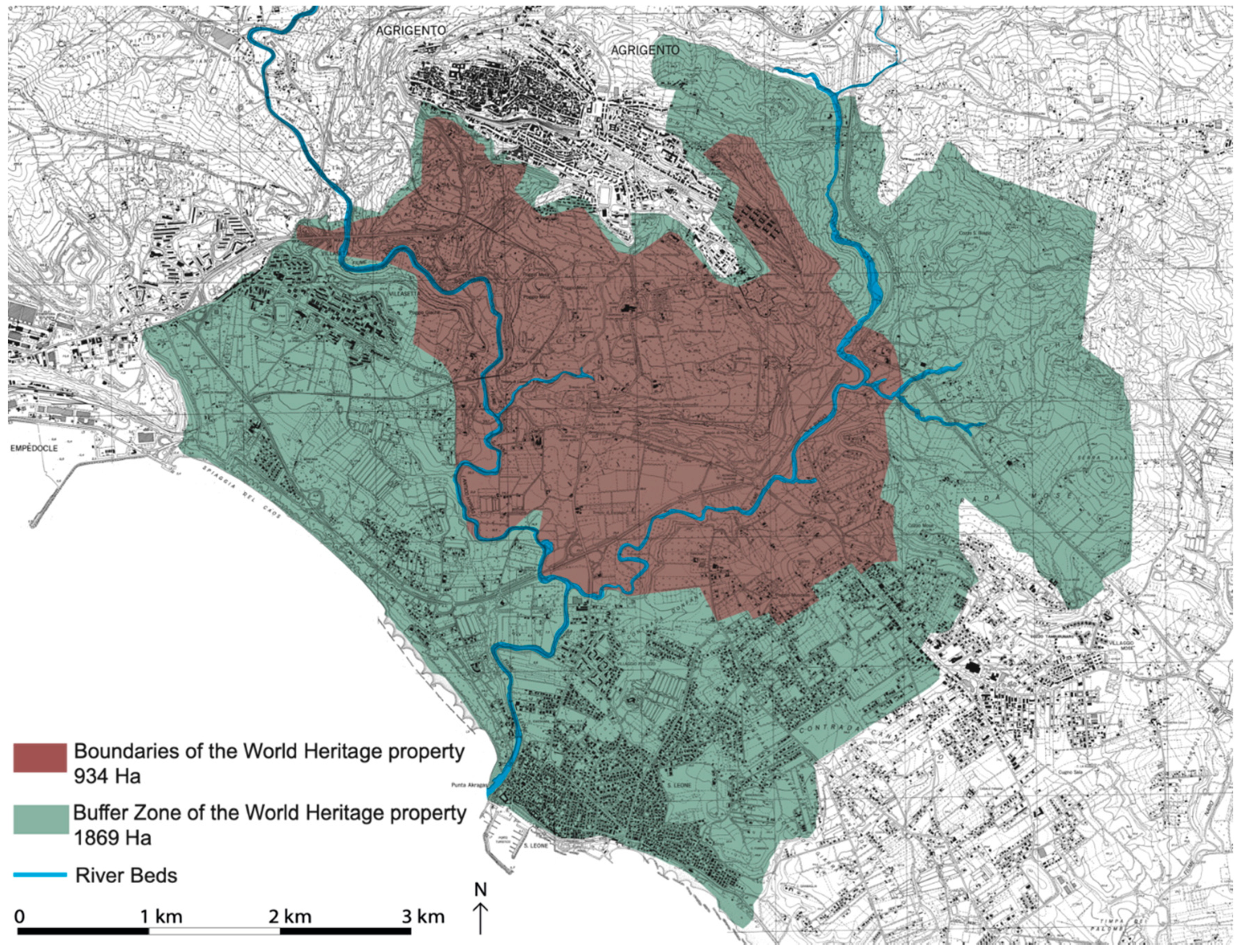
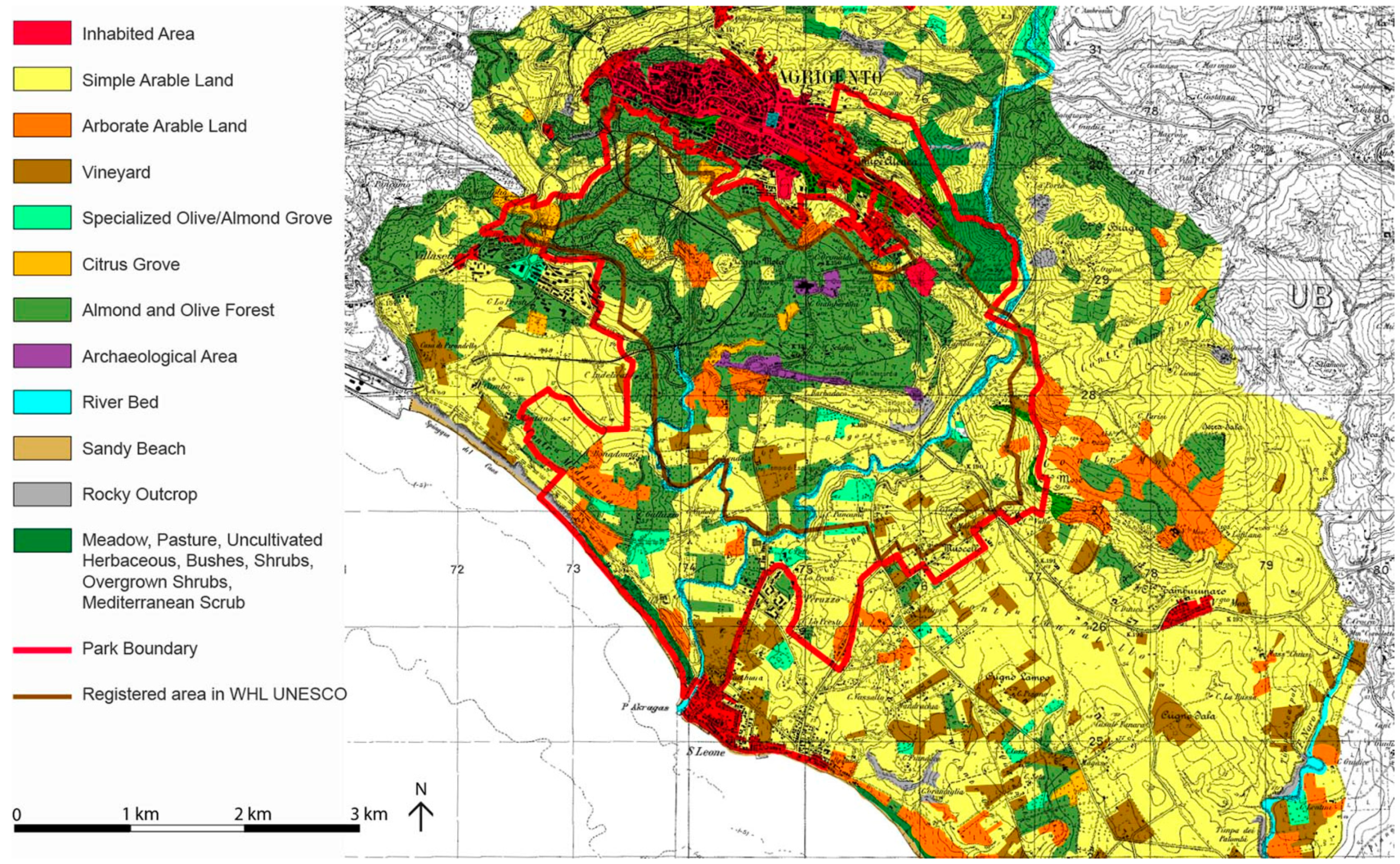

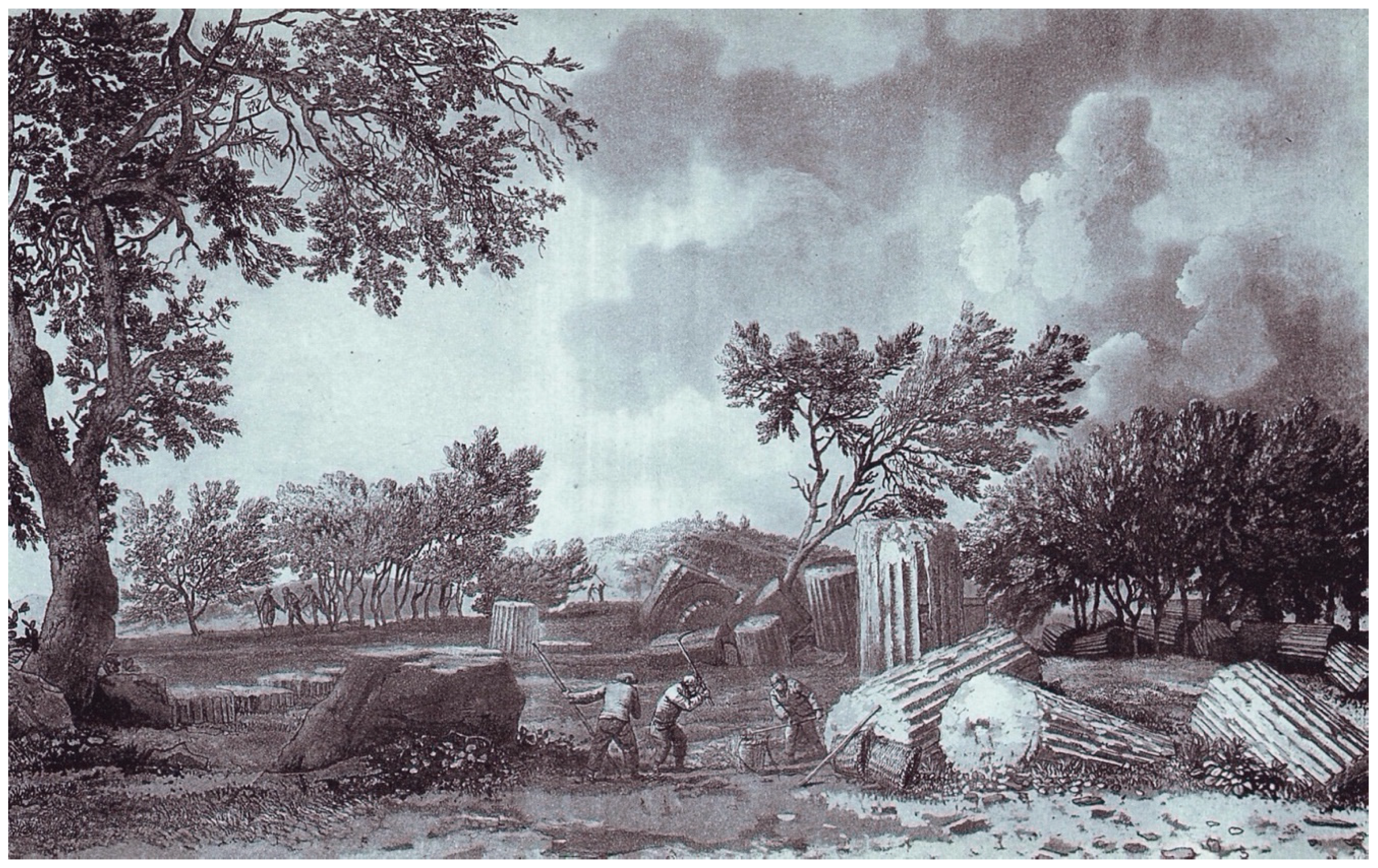


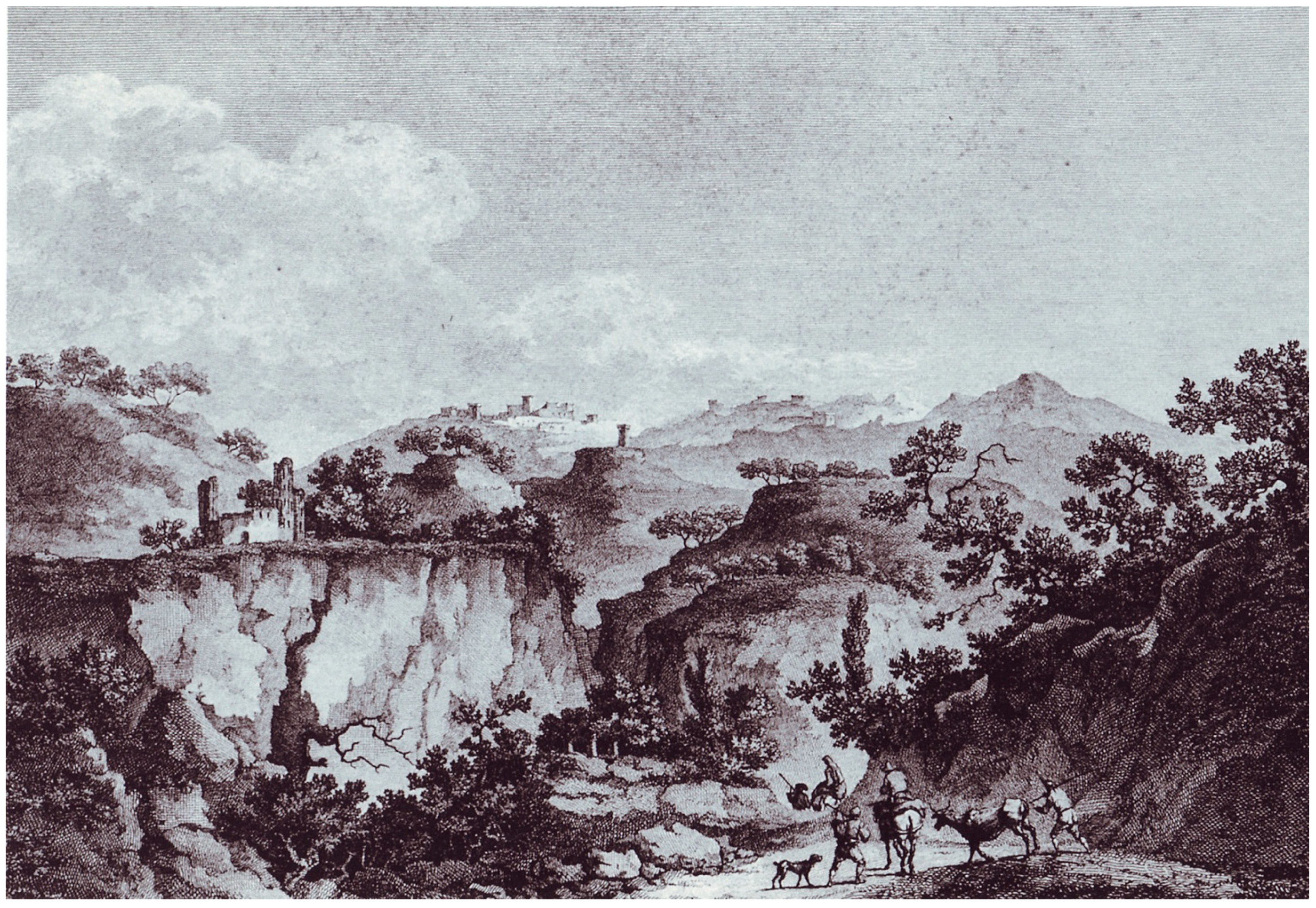


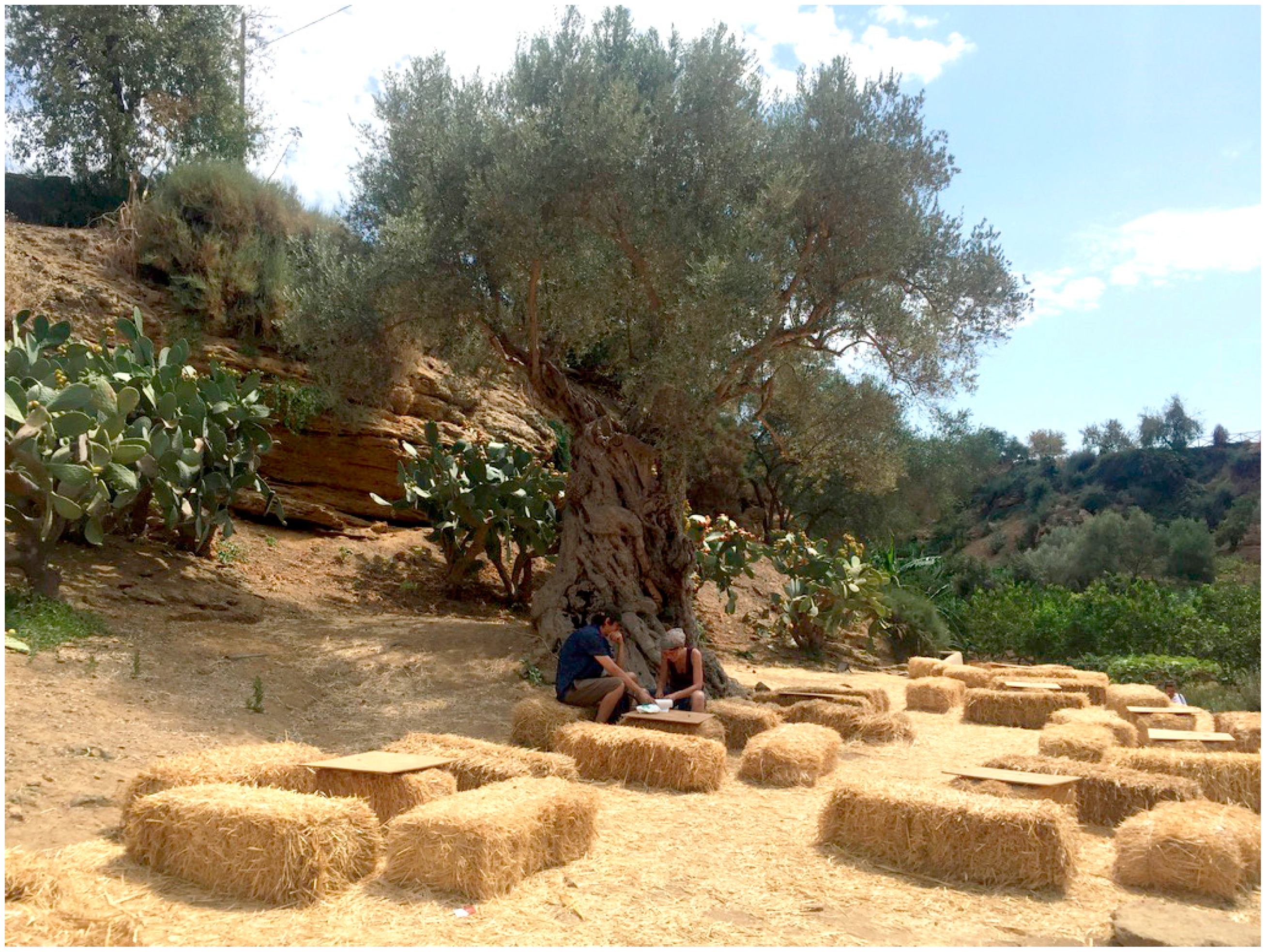


| Land Use Categories | 1955 | 2002 | Variation |
|---|---|---|---|
| Dense inhabited area | 106,581 | 749,240 | +642,659 |
| Sparsely inhabited area | 100,620 | 387,292 | +286,672 |
| Industrial area, infrastructure | 0 | 224,421 | +224,421 |
| Quarry, landfill | 7278 | 13,952 | +6674 |
| Urban green (parks and gardens) | 0 | 129,730 | +129,730 |
| Protected crops, vegetable gardens, plant nurseries | 0 | 565,829 | +565,829 |
| Simple arable land | 6,110,870 | 2,176,887 | −3,933,983 |
| Arable land planted with trees | 700,750 | 965,314 | +264,564 |
| Vineyard | 464,283 | 493,115 | +28,832 |
| Specialised olive/almond grove | 299,540 | 1,073,318 | +773,778 |
| Citrus grove | 285,714 | 132,150 | −153,564 |
| Almond and olive forest | 5,193,362 | 4,104,387 | −1,088,975 |
| Meadow, pasture, uncultivated herbaceous | 302,636 | 977,084 | +674,448 |
| Bushes, shrubs, overgrown shrubs | 148,160 | 378,515 | +230,355 |
| Mediterranean bush | 150,811 | 62,308 | −88,503 |
| Wood | 0 | 1,168,487 | +1,168,487 |
| Archaeological area | 169,450 | 262,659 | +93,209 |
| Riverbed | 403,834 | 409,479 | +5,645 |
| Sandy beach | 57,182 | 104,788 | +47,606 |
| Rocky outcrop | 75,290 | 220,235 | +144,945 |
| Transformations of the Landscape of the Area between the City of Agrigento and the Coast | Transformations of the Landscape of the Park of the Valley of the Temples (Boundary of the Park, R.L. 3.11.2000 n. 20) |
|---|---|
|
|
|
|
|
|
|
|
|
| Crops | Authors (Period) | |||||||||||
|---|---|---|---|---|---|---|---|---|---|---|---|---|
| Diodoro (1st cent. BC) | Idrisi (1138) | Riedesel (1767) | Brydone (1770) | Swinburne (1770) | Münter (1785) | Goethe (1787) | Stolberg (1792) | Seume (1802) | Didier (1829) | Laugel (1872) | Vuiller (1897) | |
| Vineyards | • | • | • | • | • | • | ||||||
| Fruit trees | • | • | • | • | ||||||||
| Pastures | • | |||||||||||
| Olive groves | • | • | • | • | • | • | • | • | ||||
| Wheat | • | • | • | • | • | • | ||||||
| Barley | • | |||||||||||
| Vegetable gardens | • | |||||||||||
| Gardens | • | • | • | • | ||||||||
| Almond trees | • | • | • | • | • | • | • | |||||
| Citrus trees | • | |||||||||||
| Pomegranate trees | • | • | ||||||||||
| Pistachio trees | • | • | ||||||||||
| Table grapes | • | |||||||||||
| Fig trees | • | • | • | |||||||||
| Carob trees | • | • | • | • | ||||||||
| Legumes/broad beans | • | • | ||||||||||
| Oats | • | |||||||||||
| Melons | • | |||||||||||
| Artichokes | • | |||||||||||
| Broccoli | • | |||||||||||
| Cabbages | • | |||||||||||
| Forage | • | • | • | • | ||||||||
| Tumenia (soft wheat) | • | |||||||||||
| Mulberry trees | • | |||||||||||
| Prickly pear trees | • | • | ||||||||||
| Aloe/Agave/Acanthus | • | • | • | |||||||||
| Ferula (giant fennel) | • | • | • | |||||||||
| Flax | • | |||||||||||
Publisher’s Note: MDPI stays neutral with regard to jurisdictional claims in published maps and institutional affiliations. |
© 2021 by the author. Licensee MDPI, Basel, Switzerland. This article is an open access article distributed under the terms and conditions of the Creative Commons Attribution (CC BY) license (https://creativecommons.org/licenses/by/4.0/).
Share and Cite
Badami, A.A. Managing the Historical Agricultural Landscape in the Sicilian Anthropocene Context. The Landscape of the Valley of the Temples as a Time Capsule. Sustainability 2021, 13, 4480. https://doi.org/10.3390/su13084480
Badami AA. Managing the Historical Agricultural Landscape in the Sicilian Anthropocene Context. The Landscape of the Valley of the Temples as a Time Capsule. Sustainability. 2021; 13(8):4480. https://doi.org/10.3390/su13084480
Chicago/Turabian StyleBadami, Angela Alessandra. 2021. "Managing the Historical Agricultural Landscape in the Sicilian Anthropocene Context. The Landscape of the Valley of the Temples as a Time Capsule" Sustainability 13, no. 8: 4480. https://doi.org/10.3390/su13084480
APA StyleBadami, A. A. (2021). Managing the Historical Agricultural Landscape in the Sicilian Anthropocene Context. The Landscape of the Valley of the Temples as a Time Capsule. Sustainability, 13(8), 4480. https://doi.org/10.3390/su13084480






